Turmeric, part of the ginger family, contains curcumin, a powerful antioxidant that has been shown to be beneficial in skincare.
It has been used for centuries in Ayurveda and Chinese medicine to treat various ailments and it is well-known throughout India to treat hyperpigmentation, reduce redness and promote even skin tone.
Both turmeric and ginger have anti-bacterial, antioxidant and anti-inflammatory properties.
Pamper yourself with this turmeric and ginger handmade soap that also contains skin-nourishing cocoa and shea butter to moisturize and soften skin.
If you’re looking for more DIY recipes containing Turmeric, check out some of my other posts:
- DIY Turmeric Face and Body Scrub
- Sandalwood and Ghee Soap Recipe
- Neem and Turmeric Handmade Soap
- Activated Charcoal and Turmeric Soap
Interested in learning more about natural soap making? Check out Natural Soapmaking by The Nerdy Farmwife.
Ingredients
- 12 oz Olive oil
- 9 oz Coconut oil
- 3 oz Palm oil
- 1 oz Castor oil
- 2 oz Shea butter
- 2 oz Cocoa Butter
- 11 oz Distilled water
- 4.1 oz Sodium Hydroxide
- 1 oz Fragrance or essential oil
- 2 tbsp Turmeric powder
- 1 oz Ginger, finely grated
- 2 teabags of natural Turmeric and Ginger tea (optional)
If you are new to making soap, see my post on Basic Soapmaking for Beginners as well as the tools that are needed.
Directions to Make Turmeric and Ginger Soap
As usual, suit up for safety before you begin working with sodium hydroxide (lye). Ensure that there are no pets or children in the area where you will be preparing your soap.
Put on your long sleeves, gloves and safety goggles.
The first step is to make your lye solution and set it aside to allow it to cool. I allowed it to cool completely to room temperature.
In a heatproof container, weigh out your water.
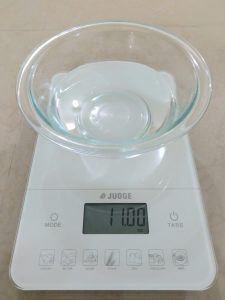
Next, weigh your sodium hydroxide.

In a well-ventilated area, pour the sodium hydroxide into the water and stir it with a stainless steel spoon until it is fully dissolved. The solution will give off heat and fumes, ensure that you do not inhale the fumes.
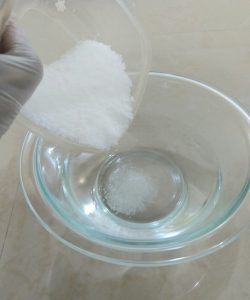
Set the solution aside in a safe area while it cools.
Prepare your other ingredients.
Thoroughly wash your ginger. I used the peel in the soap, but you can peel yours if you prefer. Using the fine side of a grater or a food processor, grate or grind the ginger.
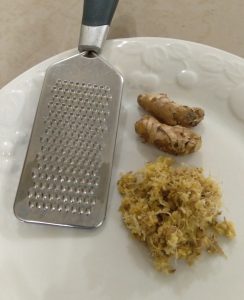
I used 1 ounce of grated ginger in my soap.
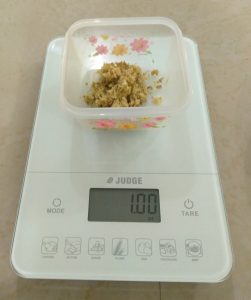
Measure two tablespoons of turmeric powder and set it aside as well.
In addition to the grated ginger and turmeric powder, I used the contents of two teabags of natural 100% turmeric and ginger tea, pictured below. This is totally optional. I like to use it for a little more texture and exfoliation.
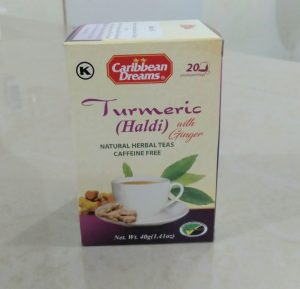
Next, weigh out your butters in a heat-proof or microwaveable bowl.
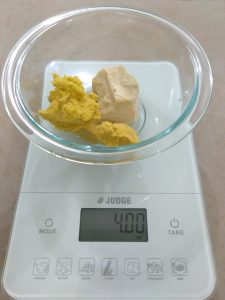
Melt the shea and cocoa butter in a double boiler or microwave. Only heat it up to melt them but do not overheat. To create a double boiler, I usually place my Pyrex bowl containing the butters in a pot with hot water on the stove and heat it until it melts.

Next, weigh your individual oils and pour them into your mixing bowl.
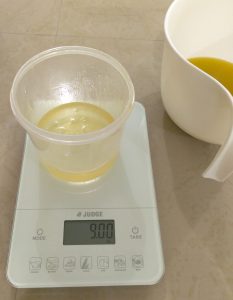
Add your butters to the bowl of oils.
At this point, I like to clear away items that are no longer needed and place only what I need in front of me so that I will not forget to add an ingredient like fragrance oil, for example.
The fragrance oil I used for this soap is Orange Patchouli from Nurture Soap. This fragrance has wonderful vibrant orange top notes and a lingering base note of earthy patchouli. I absolutely love this blend.
Now we are ready to put it all together to make our Turmeric and Ginger soap.
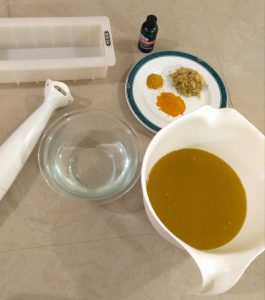
Carefully pour the lye solution into the mixture of oils and butters.
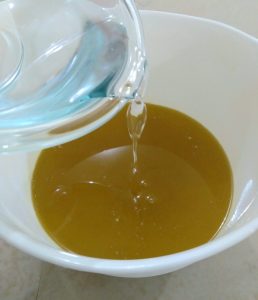
Insert the immersion blender and stir it around a bit before blending. Using a mixture of blending and stirring with the blender, bring the emulsion to trace.
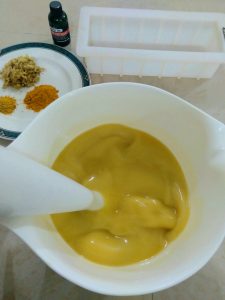
Once the soap has reached trace add your additives and fragrance or essential oil.
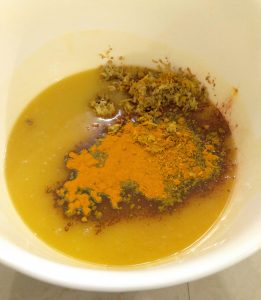
Use the blender to ensure all the ingredients are well-mixed. Note the turmeric turns a brick-red colour in the soap, this is normal.
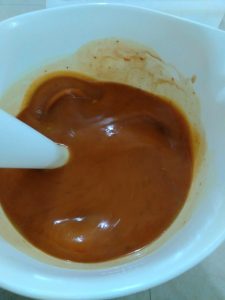
Once everything is incorporated, pour your soap into your mould.
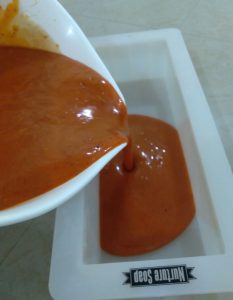
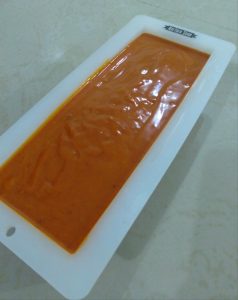
Cover your mould with a sheet of cardboard and set it aside in a safe area where it will be undisturbed. After 18 to 24 hours check to see if your soap is solid enough to take out of the mould.
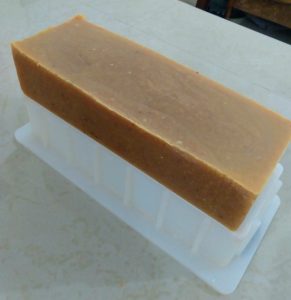
Remove the soap from the mould and cut it into bars according to your preference.
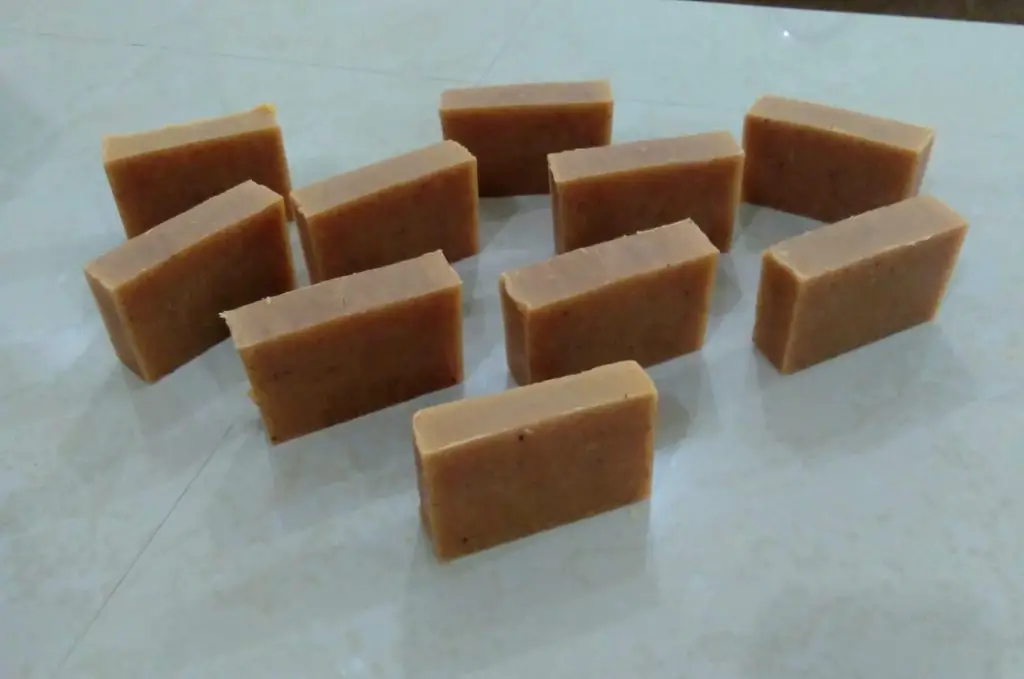
Put the soap bars in an area where they will not be disturbed, to cure for 4 to 6 weeks. Allow all sides to be exposed to air during the curing period by turning them occasionally.
After the cure, you can enjoy your awesome turmeric and ginger handmade soaps.
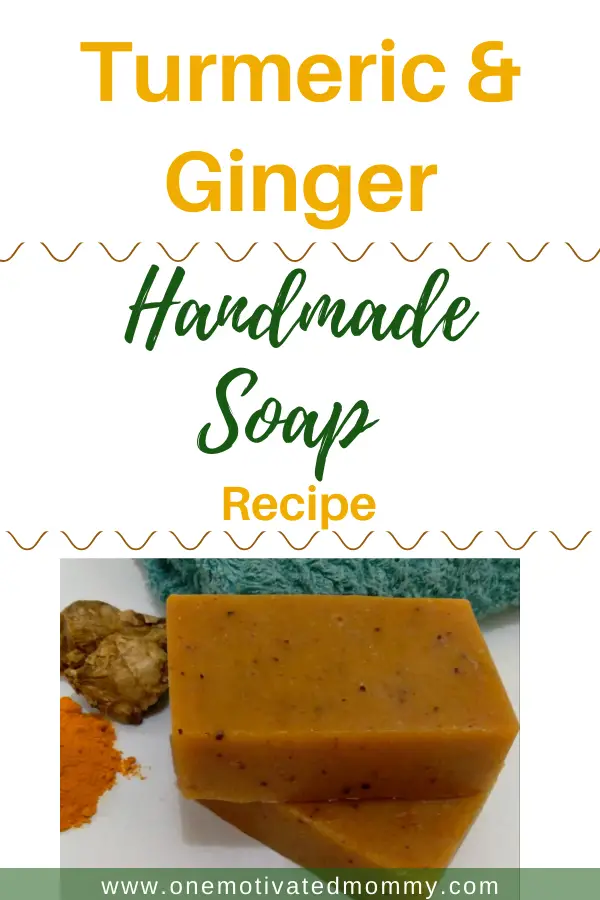

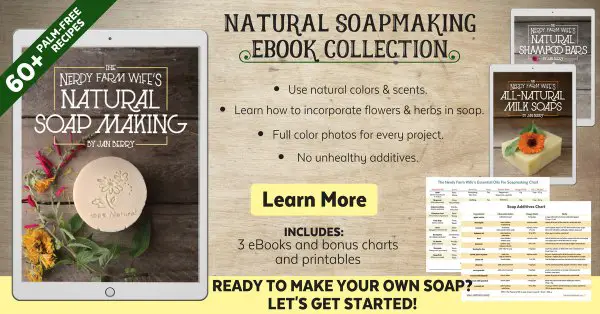
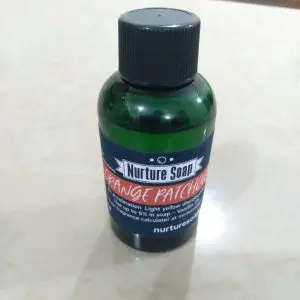
Lovely soap . It looks like something I want to eat.
Good Day, Thanks very much for your detailed soap recipe. I am interesting in start making my own soap. I would like to know how much soap did you get from that recipe listed. I would also like to know the correct measurement for making a 24 bars of soap.
Hi Bridgette.
The above recipe gave me 10 bars of soap with a weight of about 4.5 ounces before curing – the weight of the base oils is 29 ounces. If you would like to create a larger batch firstly, it would depend on the size that you would like your finished cut bars. My recipe for example could yield 12 soaps if I were to cut the bars smaller…in that case, I would double the weight of each individual oil and run it back through a lye calculator like SoapCalc to get the measurements for sodium hydroxide, water, and fragrance.
Without getting into too much of the math here, to achieve bars the same size as mine before curing, for 24 bars you would need approximately 67 ounces of total oils/fats which, based on the percentages in my recipe, would break down to 28oz Olive oil, 21oz Coconut oil, 7oz Palm oil, 2.5oz Castor oil, 4.5oz Shea Butter, 4.5oz Cocoa Butter approximately. Always run your recipe through a lye calculator when resizing a batch to determine the amount of lye and water needed. I hope this was helpful.
What temperature do your lye and oil mixture reach?
Hi Anne,
Unless I am doing hot process soap or working with recipes that contain a lot of milks or natural sugars, I generally just let the lye cool to room temperature. I live in a tropical Caribbean climate so this works for me.
However, most soapmakers prefer to soap at a temperature of 120 to 130 degrees Fahrenheit with the lye and oils being within around 10 degrees of each other.
Hi. Love your soap recipes…Question: what can i substitute the palm oil with as i dont get that in my country.
Thanks
Hi, Crystal.
Bassabu oil is the best substitute for Palm oil as it has similar properties. If you do not have access to bassabu either, you can make a perfectly balanced bar of soap with olive oil, coconut oil and castor oil. Just always be sure to run your recipe through a lye calculator to ensure that the soap has good qualities of moisturization, bubbles, creaminess, cleansing, hardness etc. If you have any more questions, let me know. Happy Soaping! 🙂
I have just made this soap, first batch ever. Thank you for sharing it so articulately.
Hi, Nawina.
I am so thrilled that you made this soap and you are very welcome. Enjoy!!! 🙂
Is this ok to use for the body or is it just used as a facial soap?
Hi Kendra,
This is great on face and body! 😊
Did you insulate your soap with a blanket or leave it just without?
Hi, Karen.
No, I did not insulate it.
I just made the Tumeric & Ginger soap however, I used goat milk instead of distilled water. Fingers crossed. This was my first batch ever of CP soap. I did the goat milk ice cube and ice bath method so it never got above 60•, alcohol I combined oils at 115•. I’m crossing my fingers and praying I did it right???
Hi, Gina.
Ooh, I am excited for you :D. Let me know how it turns out!
Does it seem to be right? I’m so nervous lol
Lol! I totally understand.
Yes, sounds like you did well for your first batch, especially as you went straight into working with goat milk! Looking forward to hearing how it turns out!
Thank you again 🤗. I asked a question on your honey and goat milk soap recipe, instead of clay, can I use oatmeal? And if so, how much?
You’re welcome. I already responded to you on the post. Let me know if you have any other questions. 🙂
hi, would this recipe be perfect for a hot process shampoo bar? sounds so good for the hair and scalp!
thanks, Manon
Hi, Manon.
Yes, it can be used hot process. My only concern with using it as a shampoo bar is that I use grated turmeric and ginger for exfoliation. Although the pieces in soap are small, I wouldn’t want pieces to end up in hair. For that reason, I would use the powdered form or pure extract without the pulp in a shampoo bar.
This soap recipe looks great! Does the ginger scent come through in the final soap?
If not, are there any natural ingredients that can lend scent to finished soap besides essential oils?
Thanks for any info 🙂
Hi, Liz. Yes, some of the natural ginger scent does come through, but it fades over time. I have found that other than essential oils, herbs that naturally have a strong fragrance, such as rosemary, for example, lends scents to the soap. Also, adding some natural clay to the soap helps the natural fragrance of the herbs to last longer.